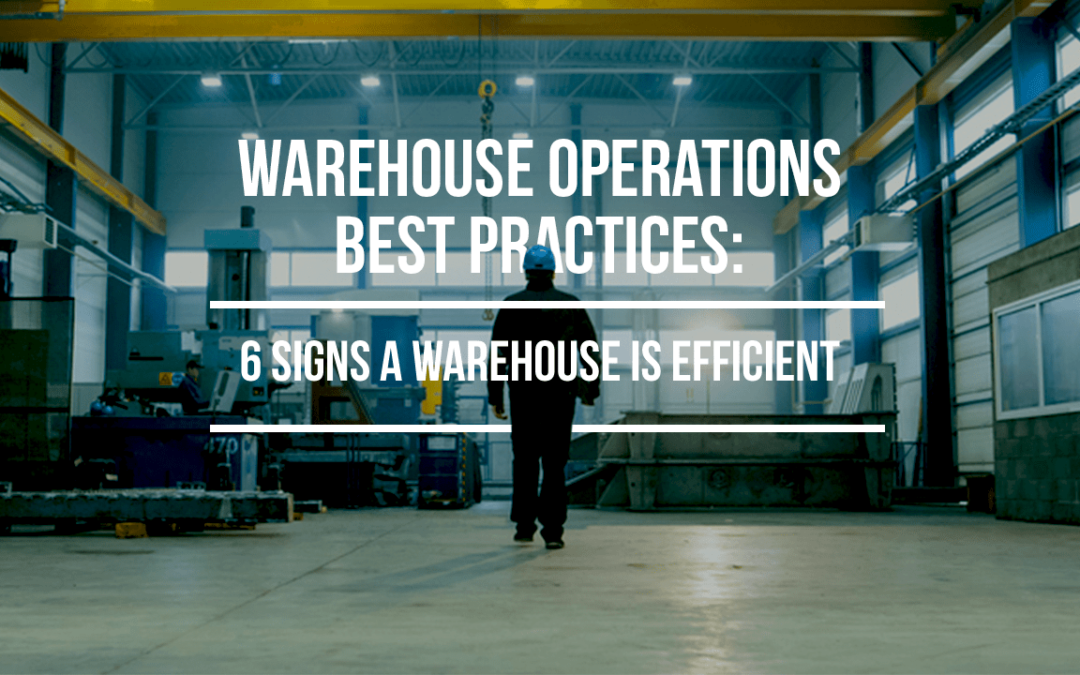Efficient operations and process flow are key to the success of any warehouse. If you’re looking to store goods at a warehouse for your business, there are several details that you should look for and ask about before signing on the dotted line. Here are 6 best practices that prove that a warehouse is efficient and worthy of your investment.
1. They Use New Technology
Technology is constantly improving, especially within the world of logistics, shipping, and warehousing. A warehousing business must keep up with the newest technology if it wants to stay relevant and successful. When you’re shopping for a warehouse, make sure they’re not stuck in the 1990s—maintaining computerized data is integral to staying on top of best practices.
A Better WMS is an Investment
The first technological improvement that a warehouse should make is to their warehouse management system (WMS). This is the program that runs the show and holds all of the data and operations materials needed to function as a top company. A company’s WMS is what will make or break their success. When it’s properly integrated into the warehouse structure and processes, a great system can reduce picking errors, increase inventory visibility, improve organizational systems, and streamline workflows.
Modern Forms of Picking
Picking is a time-consuming job at a warehouse, which is why many technological upgrades in the industry focus on modernizing it. More warehouses are adopting electronic picking because analog, paper-based picking isn’t efficient or sustainable anymore. The computerization of data allows warehouses to eliminate human error (from data entry and miscommunication) with the implementation of barcode, voice, or RFID-based software. World-class warehouse operations paved the way for the most advanced logistics technology on the market, and many others have followed in their footsteps.
Pick-to-Light Systems
Pick-to-Light technology is pretty straightforward. Every object in the warehouse has a unique barcode that is scanned before picking, which allows for accurate and efficient inventorying. This is one of the most common technological upgrades in the warehousing and logistics industry.
Hands-Free Systems
Voice picking systems are some of the most common hands-free tools being used in warehouses today. In order to maximize efficiency, all picking instructions are delivered to the operator through a headset, from the company’s WMS. Hands-free tech like these voice recognition systems eliminates the need to sort through stacks of paper and allow warehouse operations to seamlessly flow from pick to pick.
Automated Data Collection
All data entered through RFID, barcode scanners, and voice recognition systems are accurately inputted into the company’s WMS to prevent human error. Automating time-consuming tasks decreases the frequency of errors because data will be more accurate and operations decisions will be smarter. Computerizing everything allows for data synchronization between the warehouse and distribution centers, which will help make supply chain management and transportation leaner.

2. They Store Smarter
Beyond the obvious improvements that come with upgrading a WMS and picking protocol, there are ways to tell if a warehouse’s processes are truly optimized and ready for your business.
Current Inventory
One sign that something is wrong is if the company’s inventory information is unorganized and out-of-date. Technology will do nothing for an inventory that is not maintained well. If they’re not tracking and communicating effectively, they’re going to cause more headaches than not. Keeping managers and suppliers on the same page improves transparency and builds trust in a warehouse’s operations. Poorly tracked inventories can hide expired and outdated products, giving way to unseen, costly consequences. If the warehouse uses readable labels, bin locations, and accurate product and order numbers, then they’re likely staying on top of their inventory.
Streamlined Shipments
Efficient warehouses follow streamlined shipping strategies. Scheduling shipments together can speed up the warehouse receiving process and consolidate time and responsibilities, ultimately reducing costs. When working with a busy shipment schedule, implementing preplan picking waves allows warehouse employees to prepare shipments before transportation arrives. A high-quality WMS can feature plan-picking technology that can improve picking times, use of labor, and customer satisfaction.
3. Safety is Their Priority
Everyone loves efficiency and high-quality work, but safety should be a warehouse’s number one priority. Cutting corners may seem like a good way to save money in the short run, but it creates bad habits that can spell disaster. Punctuality, order fulfillment, and customer service are only sustainable through strict safety protocols.
Following safety guidelines and implementing complementary training courses takes a lot of work and time, but in the grand scheme of things, it’s one of the best things a company can do. A warehouse that adheres to strict safety guidelines is a warehouse that protects its workers, goods, and reputation. Accidents can happen, especially around heavy equipment and large objects, which makes a warehouse a hotbed of danger. Poor safety standards not only put employees at risk, but also the integrity of the goods that are stored at the location.
4. They Support Their Staff
This might seem like an obvious one, but nonetheless, employee attitudes can give you an idea of a warehouse’s integrity and values. A company that treats its employees well, pays them well, and supports them in the advancement of their career and life is a company worth investing in. Happy staffers care about the work they do, which allows a warehouse to run at top efficiency and ultimately save everyone money. A staff that does not feel supported is more likely to cut corners, make mistakes, and work slower.
Well-Trained Staff
A warehouse that cares about the health and professional development of its workers will have extensive training programs to help improve daily workflow. Whether workers are being trained on safety, cross-docking, ABC, dynamic slotting, etc, high-quality training is one of the cornerstones of efficient warehousing. An exceptional warehouse training program will set employees up for success as they polish their skills and learn new technology. Upgraded technology like scanners and voice pickers come with learning curves and workers must be trained to use them to their full potential. A trained warehouse runs like a well-oiled machine.
Communication is Key
Communication in a warehouse is an absolute must. Warehouses that do not communicate well will foster costly mistakes like missed flights and botched returns. Workers who communicate with the office and each other are more likely to meet their deadlines with quality work. If the warehouse is completely quiet, that’s a sign that the managers have failed in promoting clear and open communication. On the other hand, non-verbal communication is equally important. It’s critical to issue pick tickets with all necessary information regardless of how it is conveyed. Improving communication between branches, drivers, airlines, and supply chains can make transfers and deliveries smoother and easier.
Invest in People
Implementing workplace incentives is one technique that businesses can use to make their employees feel more supported. Everyone should be recognized for their hard work—78% of employees report that they would work harder if their efforts were recognized better. A warehouse that motivates its employees shows them how valuable they are often increases productivity and boosts their bottom line. Businesses that provide perks through annual bonuses, company celebrations, and employee referral program are more likely to increase their customer retention rates through improved employee retention rates.
5. They’re Organized
Warehouses must be efficient and organized in order to provide the best business to their customers. The location of all warehoused products should be accurately and thoroughly documented. In order for a warehouse to operate as smoothly as possible, management needs to implement a universal system to run by.
Everything in its Place
Since warehouses charge by space, it’s in their best interest to utilize all horizontal and vertical space. Most warehouses invest in pallet racks to facilitate floor-to-ceiling storage. Empty warehouse space is an expensive waste and may be a sign that the business does not have a good organizational system.
Systems for Success
One specific technique that can help improve a warehouse’s efficiency is the “ABC” Analysis. To conduct an ABC analysis, all warehoused products should be categorized by revenue generation (A being the most important/best-selling and C being the least important). This ranks an inventory based on dollar value, allowing workers to focus their attention on the more expensive goods. By giving space priority to frequently picked products like A and B, a warehouse is better able to improve the pick times and accessibility of popular items.
Everything is Tracked
The key to building a successful warehousing business is to record everything. Recording every transaction, process, and movement in the warehouse process enables managers to adjust steps and procedures in order to increase productivity. Using unique tracking, order, and inventory numbers is an integral aspect of the recording process that allows a warehouse to run at its highest potential.
6. They Continuously Improve for the Future
A business is most successful when it’s innovating and improving itself for the future. As more technology and organizational aids are introduced, a warehouse needs to adopt or innovate in order to stay relevant. A business with an aggressive development plan for the future is a business worth investing your time and money in.
Work Less, Do More
Continuous improvement sometimes means cutting out inefficiencies and wasted time. Watching and recording warehouse procedures can give managers an idea of what else can be done to make the business more productive. “Work smarter, not harder” may be cliché, but it’s true, especially in the rapidly advancing logistics industry. Some of the changes that will do the most for a warehouse’s efficiency are eliminating overproduction, extra steps, and defective goods; moving excess inventory; and addressing over-processing. By implementing a lean warehouse management framework, workflows can be optimized and processing times can be reduced. Changing these aspects in a business model can improve customer relations and improve bottom lines.
Need a Warehouse Partner You Can Trust?
Here at Bridgetown Trucking, we pride ourselves on going above and beyond these warehouse best practices. We offer a variety of trucking, warehouse, and logistics services that will make your life easier no matter your business’ size. Need transloading services? Inventory accountability? We can optimize your storage and supply chain needs so you don’t have to worry about products and supplies piling up at your location.
We provide short and long-term storage for businesses of all sizes and industries. Contact us and let’s talk about how we can help you out.

